Rose of Sharon (Althea Shrub) Profile
Written by Iris
Oct 22 2021
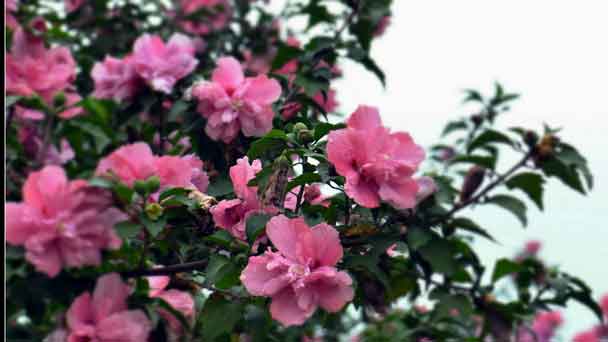
Rose of Sharon (Althea Shrub) is a hardy deciduous plant of the tropical hibiscus family. Rose of Sharon’s late flowering, striking flower shape, ease of maintenance and good drought tolerance (once established) make it ideal for gardening. One of the few summer-flowering shrubs, Rose of Sharon has 4-inch lobes or toothed leaves that come on so late in the spring that sometimes gardeners unfamiliar with the shrub worry that their plants are dead. Just be patient - the rewards will come.
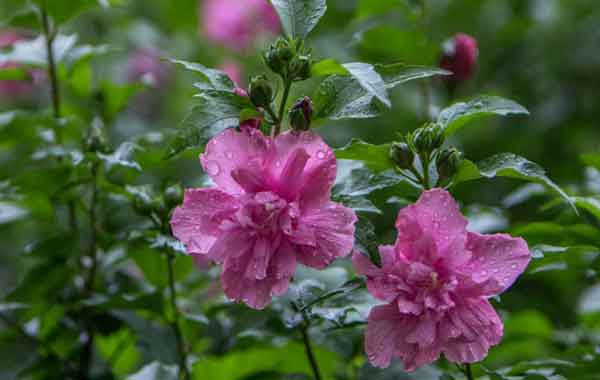
Althea Shrub Picture
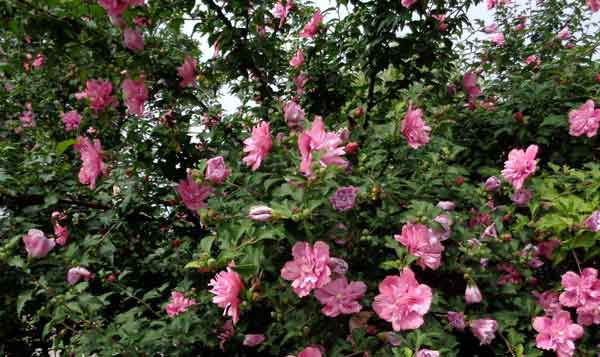
Generally, the safest way to propagate rose of sharon is to place a fresh cutting into a pot. Use a rooting hormone on the bottom part of the stem and place the lower half into a pot. Water the cutting and cover it up with clear plastic.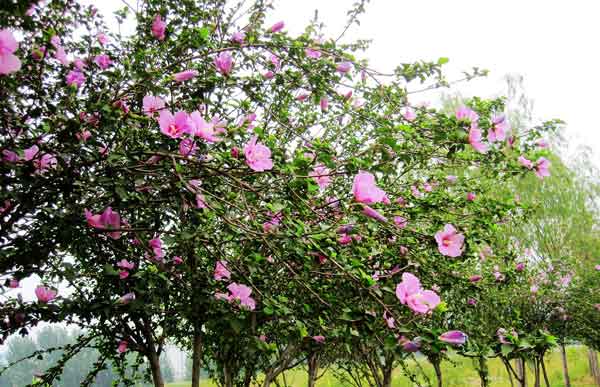
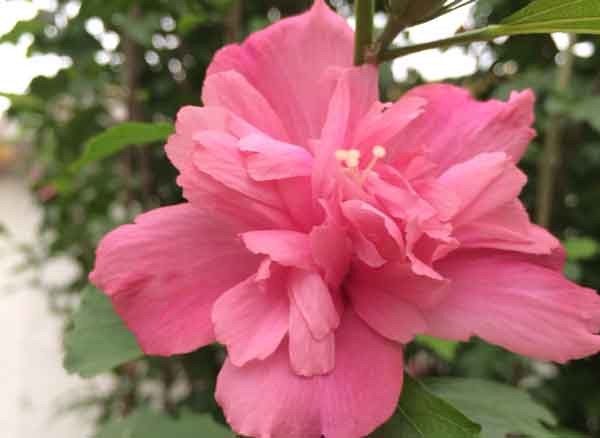
Rose of Sharon‘Purple Pillar' rose of Sharon is a beauty with semi-double, purple-pink flowers with red throats. It tops out at 10 to 16 feet tall but only grows 2 to 3 feet across, so it's a good choice for narrow spaces.
Rose of Sharon 'Lavender Chiffon' rose of Sharon is striking with its semi-double, light purple petals marked with red veins. It grows 8 to 10 feet tall, so it can be used as a small tree; just leave the central leader and remove the other branches.
Rose of Sharon 'White Chiffon' rose of Sharon is a fine choice for a moon garden, where its pure white blooms, when planted with other light-colored flowers and foliage, will reflect the moonlight. It matures at 6 to 8 feet tall.
Rose of Sharon‘Blue Satin' Chiffon has nearly true-blue petals set off by yellow stamens and splashes of red in the flowers' throats. This nearly seedless variety is sometimes sold as 'Azurri Blue Satin' and reaches 8 to 12 feet in height.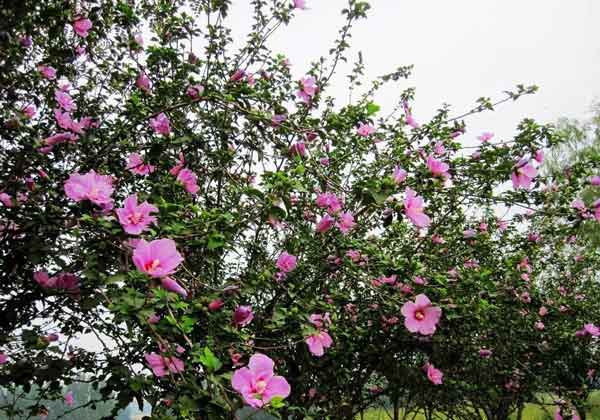
Plant three rose of Sharon shrubs in a triangular pattern to form a focal point in the landscape. Choose shrubs with the same color blooms for a uniform appearance. Mulch around the rose of Sharon for a more finished look.
Add a rose of Sharon tree to an existing flower bed to add height. Train the shrub into tree form by eliminating all but the center trunk. Prune the canopy to about 2 feet from the ground. Keep the tree pruned each winter so the canopy blooms in the spring.
Bring color to hard-to-cultivate areas of the landscape with a potted rose of Sharon. Choose a colorful pot that is deep and has good drainage holes. You can set the potted plants on patios, decks or beside pools. This versatile shrub grows just about anywhere.
Purple coneflower (Echinacea)
Phlox (Phlox)
Oriental lilies (Lilium asiatic)
Blue globe thistle (Echinops bannaticus 'Blue Glow')
Lavender (Lavendula)
Rose of Sharon PictureRose of Sharon InfoRose of Sharon Native HabitsRose of Sharon DistributionHow to Grow & Care for Rose of SharonHow to Grow Rose of SharonHow to Care for Rose of SharonRose of Sharon UsesOrnamental usesCulinary Uses for HibiscusRose of Sharon VarietiesRose of Sharon Common Pests/DiseasesRose of Sharon Design TipsRose of Sharon Companion Plants
Rose of Sharon Picture

Althea Shrub Picture
Rose of Sharon Info
| Botanical Name | Hibiscus syriacus |
| Common Name | Althea shrub, Korean rose, rose mallow, Chinese hibiscus, Rose of Sharon |
| Plant Type | Shrub |
| Mature Size | 8-12 ft. tall, 6-10 ft. wide |
| Sun Exposure | Full sun to part shade |
| Soil Type | Moist |
| Soil pH | Neutral to acidic, alkaline |
| Bloom Time | Late summer, early fall |
Rose of Sharon Native Habits
Rose of Sharon prefers direct sunlight or partial shade. Therefore, plant it in a spot that gets at least four hours of sun every day. Keep in mind that to get the gorgeous flowers, you need to protect the plant from the midday sun during the summer.This shrub is easy to maintain because the plant is resistant to drought and salt. The pollution doesn’t damage the rose of Sharon either, so if you live in an urban area, it is a safe choice for your garden. While pests could attack your rose of Sharon, the only one that can damage this shrub is a Japanese beetle. Make sure you provide your rose of Sharon with a lot of moisture after you plant it. It thrives in slightly acidic soil that is also well-drained. The perfect time for planting rose of Sharon is either in spring or fall. The leaves should appear in late spring, but keep in mind that this plant is a slow grower.Rose of Sharon Distribution
There are more than 250 species of hibiscus, but one that is considered a heritage-type plant is the rose of Sharon, also called althea. Rose of Sharon were very common in Southern nurseries in the 1800s, so they have been around a long time. Rose of Sharon (Hibiscus syriacus) is native to China and India, and was one of the many plants grown from seed by Thomas Jefferson. The name hibiscus is from an ancient Greek name for "mallow," for this plant was thought to resemble the mallow blossom. Traditional varieties can get quite large in size, and are typically grown as large shrubs or small patio trees. One of the problems cited in many publications is that Rose of Sharon are invasive in many areas of the United States. Homeowners report that they love the flowers but hate the hundreds of seedlings that they generate.
How to Grow & Care for Rose of Sharon
How to Grow Rose of Sharon
- With Seeds
- With Cuttings
Generally, the safest way to propagate rose of sharon is to place a fresh cutting into a pot. Use a rooting hormone on the bottom part of the stem and place the lower half into a pot. Water the cutting and cover it up with clear plastic.
How to Care for Rose of Sharon
- Light
- Soil
- Water
- Temperature and Humidity
- Fertilizer
- Pruning
- Pests and Diseases

Rose of Sharon Uses
Ornamental uses
As an ornamental shrub, Rose of Sharon makes for a good specimen plant in small gardens. However, it can also be planted as a small group of shrubs. It looks particularly beautiful as a flowering hedge made up of different Hibiscus varieties. Insects also enjoy the nectar-rich flowers.Culinary Uses for Hibiscus
Every part of The Rose of Sharon is edible leaves, blossoms and bark- it contains vitamin C and, Anthocyanins which are antioxidants. The young leaves can be eaten raw or cooked. They have a very mild flavor, but get tough as they age, good when mixed with a softer leaved lettuce. You can make tea from the leaves or the flowers. Flowers – raw or cooked. A mild flavor and mucilaginous texture, they are better than the leave in a salad, both for looking at and for eating. The root is edible but very fiber-y; mucilaginous and without very much flavor.
Rose of Sharon Varieties
Rose of Sharon‘Lil' Kim' is a dwarf rose of Sharon with red, purple or white blooms. It matures at 3 to 4 feet tall and wide. The leaves are small, so you see a lot of colorful blooms as opposed to foliage. The flowers often last up to three days, while most rose of Sharon blooms fade after just one day.Rose of Sharon‘Purple Pillar' rose of Sharon is a beauty with semi-double, purple-pink flowers with red throats. It tops out at 10 to 16 feet tall but only grows 2 to 3 feet across, so it's a good choice for narrow spaces.
Rose of Sharon 'Lavender Chiffon' rose of Sharon is striking with its semi-double, light purple petals marked with red veins. It grows 8 to 10 feet tall, so it can be used as a small tree; just leave the central leader and remove the other branches.
Rose of Sharon 'White Chiffon' rose of Sharon is a fine choice for a moon garden, where its pure white blooms, when planted with other light-colored flowers and foliage, will reflect the moonlight. It matures at 6 to 8 feet tall.
Rose of Sharon‘Blue Satin' Chiffon has nearly true-blue petals set off by yellow stamens and splashes of red in the flowers' throats. This nearly seedless variety is sometimes sold as 'Azurri Blue Satin' and reaches 8 to 12 feet in height.
Rose of Sharon Common Pests/Diseases
Rose of Sharon (Althea Shrub) is susceptible to flower bud drop, which happens when soil moisture levels fluctuate widely. Regular watering helps prevent this. Leaf spot, a common fungal disease that affects althea, can be treated with a sulfur plant fungicide. Sulfur fungicides are available as a fine powder, which you dust over the leaves. You can also mix the dust with water at a rate of 3 tablespoons per 1 gallon of water and apply it with a garden sprayer. Apply the dust or spray every 10 to 14 days, as needed. Althea is relatively pest-resistant but it is sometimes bothered by aphids or spider mites. To control the pests, spray the plant with a ready-to-use insecticidal soap spray until all leaf surfaces are covered. Repeat every seven to 10 days, until the infestation is under control. Neither fungicides nor insecticidal soap should be used when temperatures are above 90 degrees Fahrenheit, or when the sun is shining directly on the plant. Wear eye protection, protective gloves, long sleeves, long pants and sturdy shoes when applying garden chemicals.
Rose of Sharon Design Tips
Create a wall of blooms by planting several rose of Sharon shrubs in a straight line. Space the shrubs at least 6 feet apart. The shrubs will fill in the empty space as they grow. You can use the shrubs to form a living privacy fence or as a backdrop to shorter plants.Plant three rose of Sharon shrubs in a triangular pattern to form a focal point in the landscape. Choose shrubs with the same color blooms for a uniform appearance. Mulch around the rose of Sharon for a more finished look.
Add a rose of Sharon tree to an existing flower bed to add height. Train the shrub into tree form by eliminating all but the center trunk. Prune the canopy to about 2 feet from the ground. Keep the tree pruned each winter so the canopy blooms in the spring.
Bring color to hard-to-cultivate areas of the landscape with a potted rose of Sharon. Choose a colorful pot that is deep and has good drainage holes. You can set the potted plants on patios, decks or beside pools. This versatile shrub grows just about anywhere.
Rose of Sharon Companion Plants
Nearly any will work, but the following perennials are especially complementary when used for rose of Sharon companion plants:Purple coneflower (Echinacea)
Phlox (Phlox)
Oriental lilies (Lilium asiatic)
Blue globe thistle (Echinops bannaticus 'Blue Glow')
Lavender (Lavendula)
Latest Updated
- Benefits of Bugleweed - 7 Science-backed Health Benefits
- Bugleweed Dangers & Side Effects - Is It Poisonous?
- How to Plant Evergreen Trees - What You Should Know
- When to Plant Evergreens - Grow Guide for Evergreen Trees
- 12 Wonderful Evergreen Shrubs for Your Garden
- 12 Popular Evergreen Plants with Pictures for Beginners
- When And How To Prune A Lilac Bush Like a Pro
- How to Grow & Care for Lilac Vine (Hardenbergia Violacea)
- Japanese Lilac Tree (Syringa Reticulata) Care & Propagation Guide
- Shumard Oak Pros and Cons - What to Know
Popular Articles
- Winter maintenance of Antirrhinum Majus
- How to Grow Terminalia Mantaly Tree
- How to Grow and Care for Crossostephium Chinense
- How to grow Antirrhinum Majus in spring
- Peristeria Elata (Dove Orchid) Profile: Info & Care Guide
- Underwatered Snake Plant (Sansevieria Trifasciata) - Signs And How To Fix
- How to Care for Brazilian Jasmine Plant (Mandevilla Sanderi)
- How to Grow & Care for Graptopetalum Purple Delight in Summer
- Rosa Chinensis (China Rose): Plant Growing & Care Tips
- How to Care for Baby Sun Rose (Aptenia Cordifolia)